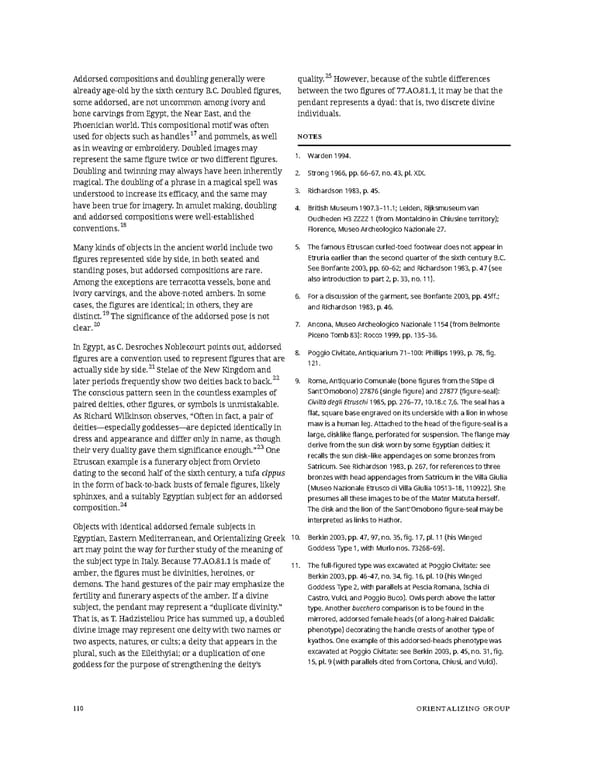Addorsed compositions and doubling generally were quality.25 However, because of the subtle differences already age-old by the sixth century B.C. Doubled figures, between the two figures of 77.AO.81.1, it may be that the some addorsed, are not uncommon among ivory and pendant represents a dyad: that is, two discrete divine bone carvings from Egypt, the Near East, and the individuals. Phoenician world. This compositional motif was often used for objects such as handles17 and pommels, as well NOTES as in weaving or embroidery. Doubled images may represent the same figure twice or two different figures. 1. Warden 1994. Doubling and twinning may always have been inherently 2. Strong 1966, pp. 66–67, no. 43, pl. XIX. magical. The doubling of a phrase in a magical spell was understood to increase its efficacy, and the same may 3. Richardson 1983, p. 45. have been true for imagery. In amulet making, doubling 4. British Museum 1907.3–11.1; Leiden, Rijksmuseum van and addorsed compositions were well-established Oudheden H3 ZZZZ 1 (from Montalcino in Chiusine territory); conventions.18 Florence, Museo Archeologico Nazionale 27. Many kinds of objects in the ancient world include two 5. The famous Etruscan curled-toed footwear does not appear in figures represented side by side, in both seated and Etruria earlier than the second quarter of the sixth century B.C. standing poses, but addorsed compositions are rare. SeeBonfante 2003, pp. 60–62; and Richardson 1983, p. 47 (see Among the exceptions are terracotta vessels, bone and also introduction to part 2, p. 33, no. 11). ivory carvings, and the above-noted ambers. In some 6. For a discussion of the garment, see Bonfante 2003, pp. 45ff.; cases, the figures are identical; in others, they are andRichardson 1983, p. 46. distinct.19 The significance of the addorsed pose is not clear.20 7. Ancona, Museo Archeologico Nazionale 1154 (from Belmonte Piceno Tomb 83): Rocco 1999, pp. 135–36. In Egypt, as C. Desroches Noblecourt points out, addorsed 8. Poggio Civitate, Antiquarium 71–100: Phillips 1993, p. 78, fig. figures are a convention used to represent figures that are 121. actually side by side.21 Stelae of the New Kingdom and later periods frequently show two deities back to back.22 9. Rome, Antiquario Comunale (bone figures from the Stipe di The conscious pattern seen in the countless examples of Sant’Omobono) 27876 (single figure) and 27877 (figure-seal): paired deities, other figures, or symbols is unmistakable. Civiltà degli Etruschi 1985, pp. 276–77, 10.18.c 7,6. The seal has a As Richard Wilkinson observes, “Often in fact, a pair of flat, square base engraved on its underside with a lion in whose deities—especially goddesses—are depicted identically in maw is a human leg. Attached to the head of the figure-seal is a dress and appearance and differ only in name, as though large, disklike flange, perforated for suspension. The flange may their very duality gave them significance enough.”23 One derive from the sun disk worn by some Egyptian deities; it Etruscan example is a funerary object from Orvieto recalls the sun disk–like appendages on some bronzes from dating to the second half of the sixth century, a tufa cippus Satricum. See Richardson 1983, p. 267, for references to three in the form of back-to-back busts of female figures, likely bronzes with head appendages from Satricum in the Villa Giulia (Museo Nazionale Etrusco di Villa Giulia 10513–18, 110922). She sphinxes, and a suitably Egyptian subject for an addorsed presumes all these images to be of the Mater Matuta herself. composition.24 The disk and the lion of the Sant’Omobono figure-seal may be Objects with identical addorsed female subjects in interpreted as links to Hathor. Egyptian, Eastern Mediterranean, and Orientalizing Greek 10. Berkin 2003, pp. 47, 97, no. 35, fig. 17, pl. 11 (his Winged art may point the way for further study of the meaning of Goddess Type 1, with Murlo nos. 73268–69). the subject type in Italy. Because 77.AO.81.1 is made of 11. The full-figured type was excavated at Poggio Civitate: see amber, the figures must be divinities, heroines, or Berkin 2003, pp. 46–47, no. 34, fig. 16, pl. 10 (his Winged demons. The hand gestures of the pair may emphasize the Goddess Type 2, with parallels at Pescia Romana, Ischia di fertility and funerary aspects of the amber. If a divine Castro, Vulci, and Poggio Buco). Owls perch above the latter subject, the pendant may represent a “duplicate divinity.” type. Another bucchero comparison is to be found in the That is, as T. Hadzisteliou Price has summed up, a doubled mirrored, addorsed female heads (of a long-haired Daidalic divine image may represent one deity with two names or phenotype) decorating the handle crests of another type of two aspects, natures, or cults; a deity that appears in the kyathos. One example of this addorsed-heads phenotype was plural, such as the Eileithyiai; or a duplication of one excavated at Poggio Civitate: see Berkin 2003, p. 45, no. 31, fig. goddess for the purpose of strengthening the deity’s 15, pl. 9 (with parallels cited from Cortona, Chiusi, and Vulci). 110 ORIENTALIZING GROUP
 Ancient Carved Ambers in the J. Paul Getty Museum Page 119 Page 121
Ancient Carved Ambers in the J. Paul Getty Museum Page 119 Page 121